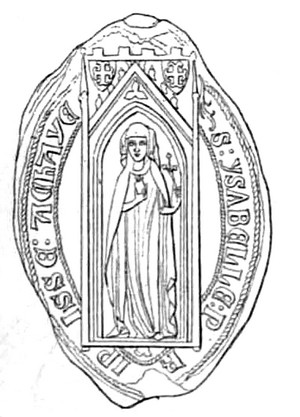Isabella of Villehardouin facts for kids
Quick facts for kids Isabella of Villehardouin |
|
|---|---|
 |
|
| Born | 1260/1263 |
| Died | 23 January 1312 |
| Spouse |
Philip of Sicily
(m. 1271; died 1277)Philip of Savoy, Lord of Piedmont
(m. 1301) |
| Issue | Matilda of Hainaut |
| House | Villehardouin |
| Father | William II of Villehardouin |
| Mother | Anna Komnene Doukaina |
Isabella of Villehardouin (born between 1260 and 1263 – died January 23, 1312) was a powerful princess who ruled the Principality of Achaea. This was a medieval state in what is now Greece. She was the princess from 1289 to 1307.
Isabella was the older daughter of Prince William II of Achaea. Her mother was Anna Komnene Doukaina. Anna was the daughter of Michael II Komnenos Doukas, a ruler from Epirus.
Contents
Isabella's First Marriage
On May 28, 1271, Isabella married Philip of Sicily. He was the son of Charles I of Sicily. This marriage was planned as part of an important agreement. It was called the Treaty of Viterbo, signed in 1267.
This treaty gave Charles I a lot of power over Achaea. It also said that if Isabella and Philip had no children, Charles I would inherit Achaea.
Philip became the King of Thessalonica in 1274. But he died on January 1, 1277, before his father. When Isabella's father, William, died in 1278, Charles I became the ruler of Achaea. This happened just as the treaty had said.
Isabella's Second Marriage and Reign
Charles I died in 1285. His son, Charles II, took over. In 1289, Isabella married Florent of Hainaut. Charles II then gave the Principality of Achaea to Isabella and Florent.
There was one condition: if Isabella outlived Florent, she could not marry again without Charles II's permission. Isabella and Florent had a daughter named Matilda.
Peace and Conflict
As Prince, Florent worked to make peace with the Byzantine Empire. They signed the Treaty of Glarentsa in 1290. This peace lasted for a few years.
In 1293, the Greeks took back the city of Kalamata. But Florent's messengers convinced the Byzantine emperor, Andronikos II Palaiologos, to return it. In 1296, the Greeks captured the castle of Saint George in Arcadia. Florent began to besiege it, but he died in 1298 before the castle was taken.
Isabella's Third Marriage and Loss of Power
Isabella married again on February 12, 1301, in Rome. Her third husband was Philip of Savoy, Lord of Piedmont. He became the new prince of Achaea.
Philip wanted to take back all of Lacedaemonia from the Byzantine Empire. He was a very strict ruler. This caused problems with the local nobles. He tried to calm them down, but they forced him to accept a special meeting called a parliament in 1304. The Greek farmers, who were struggling with high taxes, then rebelled.
In 1306, Charles II called Philip and Isabella to his court in Naples. Philip was accused of not being loyal and not helping Charles in a war. Isabella was accused of marrying Philip without Charles II's permission.
Because of this, Charles II took Achaea away from them. On May 5, 1306, he gave the principality directly to his own son, Philip I of Taranto.
Isabella's Later Life
Philip of Savoy gave up his claim to Achaea on May 11, 1307. In return, he received the County of Alba. Isabella separated from him. She went to live in Hainaut. She still believed she had a right to be princess.
Isabella died on January 23, 1312. After her death, Philip of Savoy married again. When Philip of Taranto died in 1313, Isabella's daughter, Matilda of Hainaut, became the Princess of Achaea.
Isabella's life inspired a novel by Greek writer Angelos Terzakis. It was called Princess Isabeau. It was first published in a newspaper in 1937–38.
See also
 In Spanish: Isabel de Villehardouin para niños
In Spanish: Isabel de Villehardouin para niños

